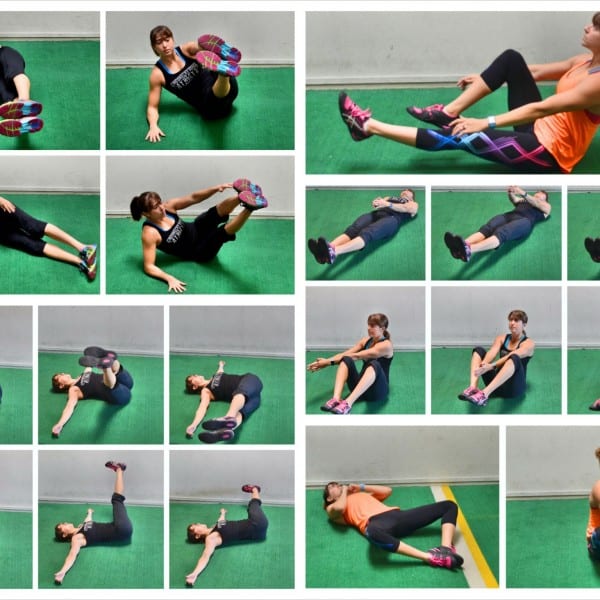TheCrunches and Sit Ups have gotten a bad rap in the last few years. They are said to be worthless and even put you at risk for injury.
And when designing many of my workouts, I often even opt for other “core moves” over Crunches and Sit Ups because they give you more”bang for your buck,” aka they work more, and bigger, muscle groups all at once to not only strengthen your entire core, but also burn more calories.
HOWEVER, there is a time and a place for Crunches and Sit Ups.
They really aren’t dangerous when you do them correctly and integrate them into your workout routine correctly.
And while they won’t give you six-pack abs, especially if your diet isn’t on point, they do have value when used correctly.
Plus, they sometimes are just freaking fun! There is just something about the ab and core burn that is produced by Crunches and Sit Ups that makes you feel good. (And sometimes working out should simply make you feel good!)
So here’s why you should do Crunches and Sit Ups and when you should include them. Plus 20 fun Crunches and Sit Up Variations!
Why You Should Do Crunches And Sit Ups
As I said, often I’ll opt for more all-inclusive core moves when I include them in my strength workouts, especially when I’m short on time.
For one, I want moves that work big muscle groups so I get more out of each movement. But two, I want moves that strengthen my body in a functional way and help teach my core to not only engage correctly, but also engage and work together in the proper sequence.
However, not all Crunches and Sit Ups are created equal.
There are some Crunch and Sit Up Exercises that I’ve found that do work more than simply your abs that I like to include because they do give you more bang for your buck. They are also functional movements, or progressions of movements, that work on core engagement and even move your body in different planes of motion.
But even if you don’t choose to use those more functional, full-core Crunches or Sit Ups, there still is a time and a place for those more isolated ab exercises.
One place I like to use Crunches and Sit Ups is during my cardio workouts.
During cardio workouts, especially interval workouts, Crunches and Sit Ups can be used as “active rest stations.” They make you keep moving while giving other areas of your body rest. Often they even let your heart rate come down while still working your abs. They aren’t an easy station, but compared to everything else, they are “rest.”
They also don’t have to be “active rest” stations during your cardio routine. They can also be a station where you really work, but may be included because you don’t want to simply keep burning out an area of your body. If you do a cardio workout, you may want to change areas worked with each interval. And to give your upper body or lower body rest, you can do an ab exercise. That way you can move quickly on each movement because an area gets to rest while another works and keeps your heart rate up until your rest interval.
Crunches and Sit Ups also DO have benefits for your core even though they are more isolated movements. Actually because they are isolated movements they can be a beneficial part of developing the mind-body connection that can lead to proper core engagement.
It can be very hard for people to get their abs to engage correctly and some Crunches and Sit Ups can be great moves to teach you how to engage your abs correct because they are more isolated movements.
If you’ve ever struggled to keep your low back from working during core movements, there are certain Crunches and Sit Ups that can help. They can be great moves because they are simple and very isolated. They allow you to just focus on engaging your abs without any other moving pieces.
However, if you simply go through the movements with Crunches or Sit Ups, or any other core moves for that matter, while allowing your low back to take over, you won’t reap any benefits.
Crunches and Sit Ups can be used to learn to engage your abs properly, and even help strengthen those deep core intrinsic stabilizers, as long as you focus on the correct muscles working during the movement.
Once you learn how to engage your abs correctly during crunches, you can then learn how to engage your abs and even brace your core correctly during other compound exercises and heavier lifts.
And the final big reason I like to include Crunches and Sit Ups throughout my workout programs is that they are simply FUN.
There is something to the burn of those more ab-focused moves that just feels so good. And focusing on muscle groups, while you can’t spot reduce, can help build them to make them look better when combined with a proper diet and full-body workout routine.
So as long as you don’t spend all your time on Crunches or Sit Ups, and make sure to include lots of compound heavy lifts as well as crunchless core movements, Crunches and Sit Ups should be a part of a good workout program.
Below are 20 Crunch and Sit Up Ab Exercises to integrated into your workout routine.
20 Ab Exercises – Fun Crunches and Sit Ups!
These 20 Ab Exercises are some great Crunch and Sit Up Variations you can include in your workouts.
Heels Up Crunch – Make one small tweak to the Basic Crunch and you instantly get more out of the movement. While this move seems super simple and easy, the Heels Up Crunch is a great way to light up your abs and really even get your lower abs engaged and working.
However, this move only works if you focus on driving your heels into the wall or down into the top of a box. If you don’t drive through your heels, you won’t engage your lower abs as much as you crunch up.

To do the Heels Up Crunch, lie on your back with your feet against a wall or on top of a box or bench. Bring your body in close enough to the wall or bench that your knees are bent to about 90 degrees. You can place your hands behind your head or keep your arms down by your sides. If you do place your hands behind your head, make sure you don’t yank on your neck as you crunch.
Then flex your feet and drive your heels hard into the box or wall. Engage your legs and your abs. Crunch your upper body up, trying to lift your shoulder blades up off the ground.
As you crunch, press your low back down into the ground and drive through your heels. Do not relax your legs.
Keep a space between your chin and your chest as you crunch up. You can either rest your head in your hands or reach your hands toward your feet as you crunch.
Crunch up then lower back down, keeping tension and driving through your heels the entire time.
Repeat moving quickly, making sure to press your low back into the ground as you crunch your upper body up.
Butterfly Crunches – Another way to change up the Basic Crunch so it engages your lower abs more is by doing the Butterfly Stretch with your legs as you crunch up. By pressing your feet together with your knees wide, you will help engage your lower abs as you crunch.
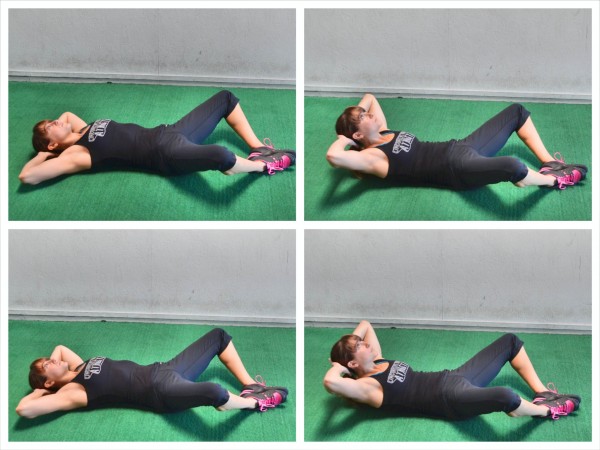
To do the Butterfly Crunches, start seated and let your knees fall open as you bring the bottom of your feet together. With the bottoms of your feet together, bring your heels in toward your body. Exactly how close you bring them in will be dependent on your flexibility and hip mobility.
Then lie back with your legs in the Butterfly Stretch. Place your hands behind your head with your elbows relaxed out wide. There should be a space between your chin and your chest as you relax your head in your hands.
Then crunch up, pressing your low back into the ground. Lift your shoulder blades up off the ground while keeping the space between your chin and your chest. Do not tug on your head with your hands to lift up higher.
Crunch up and then lower back down. Each time you crunch up, press your low back into the ground.
As you crunch, make sure that you are pressing the bottoms of your feet together to help keep everything engaged.
Oblique Crunches – So many people want to work on their “love handles.” And honestly, it isn’t bad to strengthen your core for every angle. Plus these just plan old BURN.
These Oblique Crunches work exactly what their name implies – your Obliques!

To do the Oblique Crunches, lie on your back and bend your knees to place your feet flat on the ground. Then let your knees drop to one side and your feet come up. You may need to adjust positioning slightly and move your knees and feet a bit further away or closer to your body depending on your flexibility.
Then with your knees down toward one side, place your hands behind your head. Rest your head in your hands with a space between your chin and your chest. Keep your neck relaxed and don’t tuck your chin into your chest.
Crunch up, lifting your shoulder blades up as high as you can while keeping your knees relaxed down toward one side.
As you crunch up, do not tuck your chin, but feel your abs working to lift your shoulder blades up. Lower back down and repeat. You can even put one hand on the opposite side from your knees to feel your abs working as you crunch.
Complete all reps then lower your knees down toward the other side.
Lower Body Crunch – A common “trouble zone” that people want to work on is their lower abs. While you can’t spot reduce that area, ab exercise like the Lower Body Crunch can help strengthen and really target your lower abs.
They can also be used to help strengthen your lower abs to prevent low back pain. And, when included in a proper strength and cardio routine, can help you tone that common trouble zone!

To do the Lower Body Crunch, lie on your back with our hands behind your head or down by your sides. Engage your abs using the pelvic tilt and lift your legs up off the ground, bending your knees to about 90 degrees.
Then, keeping your abs engaged and your low back pressed into the ground, straighten your legs out. Straighten them out, keeping them as close to the ground without touching as you can. Kick them out higher to make the move easier. Make sure your low back stays pressed into the ground and your abs are engaged as you full extend your legs.
Then draw your knees back in toward your chest before repeating the move.
If you struggle to keep your low back from taking over for your abs, kick your legs out higher or extend one leg at a time. You can also use one of the easier progressions of the pelvic tilt to help you learn to engage your abs.
Leg Lowers and Leg Wipers – These two moves are very advanced ab exercises that require a lot of core strength. And the Leg Wipers are a great rotational exercise to really work those obliques as well.
Make sure your abs are strong enough before attempting these moves because you don’t want your low back to take over. Do not try to compensate on the Leg Lowers by placing your hands behind your low back/butt.
Instead of using your hands to help, regress the Leg Lowers to an easier progression of the pelvic tilt to train your abs to engage so that you don’t need your hands to help you perform the movement.
Once you can do Leg Lowers, you can do the rotational variation, Leg Wipers. To regress Leg Wipers, simply bend your knees.
To do Leg Lowers, lie on your back with your arms behind your head or down by your sides and brace your abs by setting up in the pelvic tilt. Then lift your legs straight up toward the ceiling, keeping them together and as straight as possible.
Then with your low back firmly against the ground and your abs braced, lower both your legs down toward the ground. Lower them as close to the ground as possible without touching or without letting your low back come up off the ground. Keep your legs as straight as possible as you lower them down.
Then lift them back up, keeping your low back against the ground and your legs striaght. Use your abs to lift and lower.
If at any point while you lift and lower your legs, your low back comes up off the ground, stop and reset. Then either decrease your range of motion (not lowering as close to the ground) or regress to single leg lowers, lowering one leg down at a time.
If you can keep your abs engaged and not let your low back take over, lower your legs down so your heels are no more than an inch off the ground before raising them back up. You should also engage your glutes as you lower down and hover just off the ground.
And make sure that your legs stay as straight as possible throughout the movement.
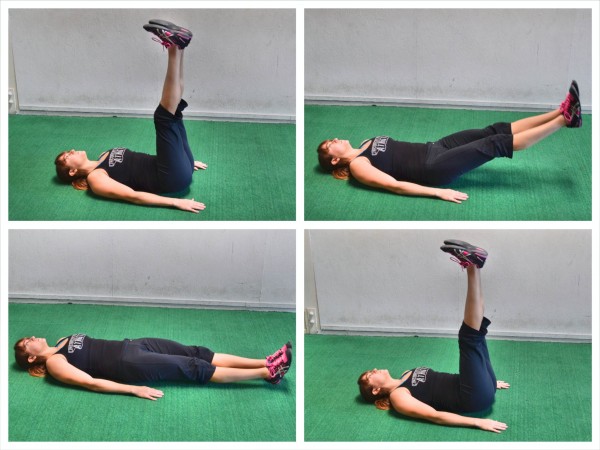
To do Leg Wipers, you will set up like you did for the Leg Lowers with your abs engaged and legs straight up toward the ceiling. Stretch your arms out at shoulder height on the ground. This will help you keep your core engaged and prevent you from completely collapsing over as you lower your legs down to each side.
Keeping your abs braced and legs straight, lower your legs down toward one side. Try not to let them move too far away from you as you slowly lower them down to one side. You want to try to keep your hips bent toward 90 degrees as you lower them down to the side. Keep your arms stretched out on the ground as you lower down.
Lower your legs close to the ground without touching all the way down. If you relax your legs down onto the ground, you release tension on your abs. So lower close but not all the way down.
Then use your abs to pull your legs back up center. Keep your legs straight as you rotate back center. Then lower toward the other side.
Only lower down as far as you can while keeping your abs engaged. Beginners may need to bend their knees to 90 degrees to do the rotations instead of keeping their legs straight.
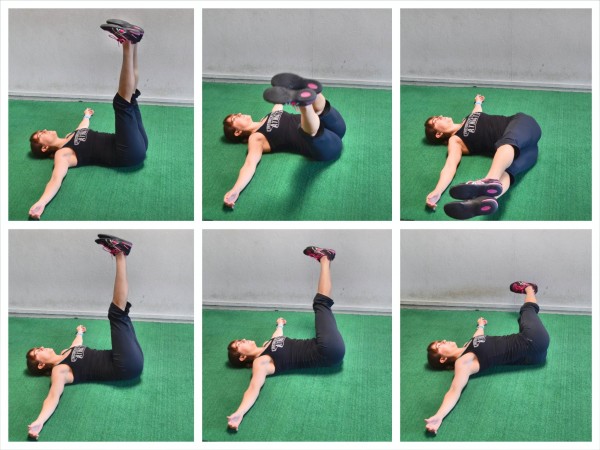
Cherry Bombs – This is a great core move that really targets the abs and even works your quads and glutes a bit. Because this is a full-body move, make sure your abs are strong enough to prevent your low back from engaging before using this exercise.

To do Cherry Bombs, start seated on the ground with your knees slightly bent and feet flat on the ground. Then lift your heels up off the ground and slightly rock back so that you are balanced on your butt. Draw your knees in toward your chest and wrap your arms around your shins.
Then open up, lying back on the ground without fully relax down and open. Keep your abs engaged and your shoulder blades slightly up off the ground as you open your arms up and out overhead. Also, keep your legs off the ground as you straighten them out and open them up wide. You should almost look like a big X on the ground with arms and legs out and open and your low back pressed against the ground.
Feel your glutes work to open your legs out wide as your abs are braced to prevent your low back from coming up off the ground.
Then come back to seated, drawing your knees back in as you wrap your arms around your shins. Try to keep your feet up off the ground the entire time.
Repeat, opening back up without completely relaxing back onto the ground.
Beginners may need to do the tuck without the full range of motion. They may need to perform more of a crunch instead of coming all the way up to balanced on their butt. To make the move harder, open your legs up while keeping them as close to the ground as possible. Kick them up and out wider higher off the ground to make the move easier.
Bicycles – In our workouts, we need to try to move in every plane of motion. We need to move forward, backward, side to side and even rotationally. And Bicycles are a great way to get us moving rotationally to work our abs.
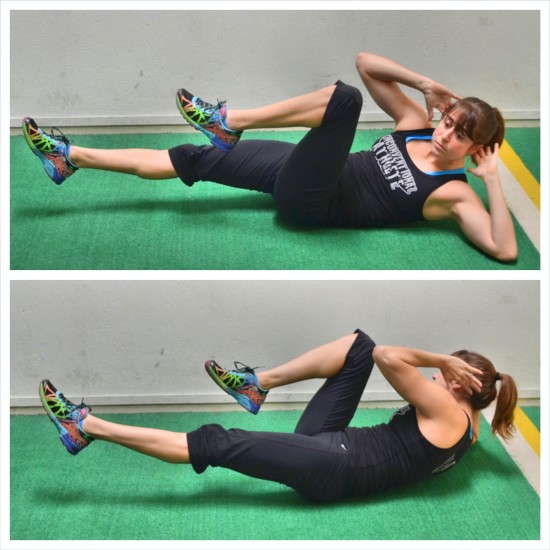
To do Bicycles, start lying on your back with your knees bent and feet flat on the ground and your hands behind your head. Press your low back into the ground and then lift your feet up off the ground, bending your hips to about 90 degrees. Then crunch up, keeping your elbows wide as you lift your shoulder blade up off the ground. Keep a space between your chin and your chest.
Then bring your right knee in toward your chest as you extend your left leg out straight. Keep the left leg up off the ground. The higher up toward the ceiling you kick it out, the easier the move will be. The closer to the ground you kick the leg out, the harder it will be.
As you bring the right knee in, crunch your upper body up and rotate to bring the left elbow up and across to touch your right knee. You don’t actually need to touch them together, but you do want to rotate that elbow toward the opposite knee. As you rotate, you can drop the other elbow down toward the ground. Try to keep your elbows wide and a space between your chin and your chest.
Then straighten your right leg out and bring your left knee in as you rotate your left elbow to the ground and your right elbow toward your left knee. Keep your abs engaged and your low back pressed into the ground as you rotate and straighten your legs out.
If you start to feel your low back take over, kick your legs out higher or even modify by keeping both knees bent and touching one toe down to the ground instead of kicking the leg out.
Keep rotating and alternating touches until all reps are complete.
Super Crunches – Want to make crunches even harder while hitting your abs from slightly different angles? Then you need to try Super Crunches. The three different reaches, will really work your entire abdominal region.
And while a very tough ab exercise, it does also really work your hips so make sure to do some extra hip stretches before and after using this move in your workouts.
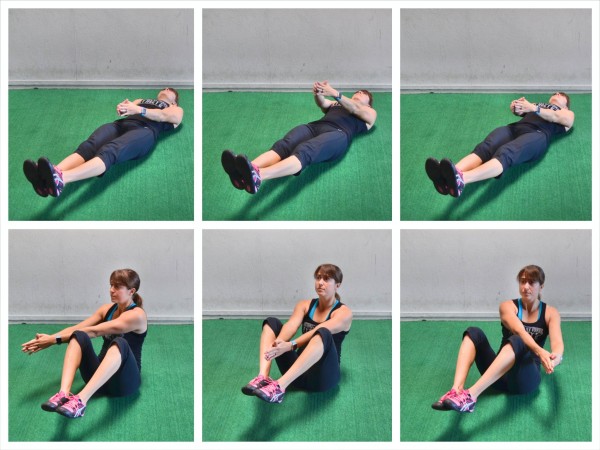
To do Super Crunches, start by lying on your back with your legs out straight on the ground in front of you and your arms together in front of you.
Then sit up, coming up to balance on your butt as you tuck your knees in and reach your hands toward the outside of one knee.
Then lie back down, but do not fully relax back onto the ground. Press your low back into the ground as you straighten your legs out and keep them off the ground. You can even stay slightly crunched up with your shoulder blades slightly lifted up off the ground to help keep your abs engaged. Do not fully release and relax back onto the ground.
Then sit back up and reach between your knees. Keep your feet off the ground and balance on your butt as you reach between your legs.
Lie back down then crunch up and reach outside the other knee. Those 3 crunches equal one rep.
Make sure that as you relax back open between reps, you keep your abs engaged. If you feel your low back engage, don’t straighten your legs out as close to the ground. Keep your legs up higher. Or even perform more of a crunch as you perform the reaches instead of coming all the way up onto your butt.
Banana Twists – If you want to make the Russian Twist more challenging without adding weight, you should try Banana Twists. This move combines the Banana Hold, an even more challenging pelvic tilt progression than Leg Lowers, with the Russian Twist to really work and blast the entire frontside of your core.
Plus this move makes you work in two different planes of motion!
Make sure that you don’t feel your low back taking over during this move. If you don’t feel your abs working, you won’t get as much out of this exercise!
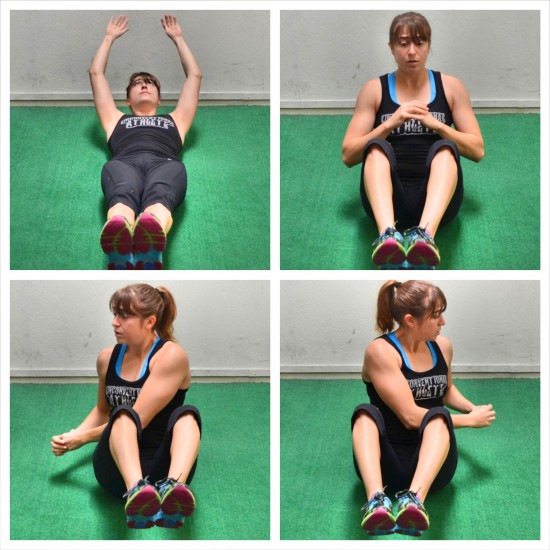
To do Banana Twists, start lying on your back with your legs out straight in front of you and your arms relaxed overhead on the ground so that your biceps are by your ears. Draw your legs together and keep your arms up by your head as you lift up into Banana.
Engage your abs as you press your low back into the ground to crunch your shoulder blades up and lift your legs a few inches up off the ground. Beginners may need to lift their legs up higher to keep their low back against the ground. Do not tuck your chin as you hold in Banana. Try to keep your neck relaxed.
Then, without touching your feet down or using your hands to push up, come up to balance on your butt. As you come up to balance on your butt, bending your knees slightly to bring them in toward your chest as you bring your hands down and together in front of your chest.
While balanced on your glutes with your feet up off the ground and your hands together, rotate your hands down toward the ground outside one hip and then back up and across your body toward the ground outside the other hip. Try to stay balanced without touching your feet down as you rotate.
Bring your hands back center and then lie back down into Banana, extending your arms overhead while straightening your legs out. Do not completely relax out. Keep your abs engaged and press your low back into the ground as you keep your shoulder blades slightly crunched up and your legs up off the ground.
Then repeat, sitting back up and twisting each way.
Snow Angels – Add some movement to the Basic Boat Hold with this Sit Up Variation, Snow Angels. Your core will have to work to keep you balanced as you move your arms up and down to the sides. This move also really works your entire frontside, including your abs, quads and even your shoulders.
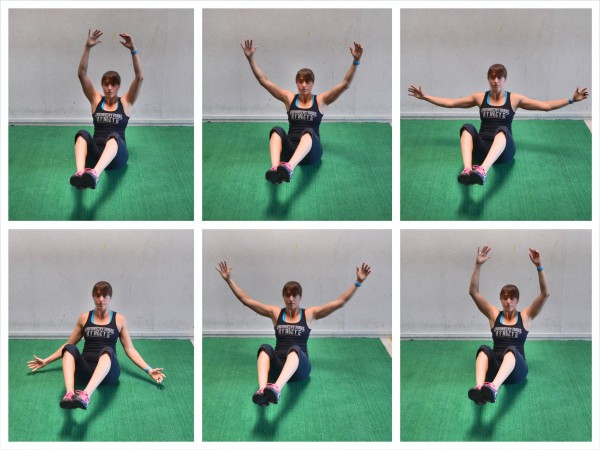
To do Snow Angels, start seated on your butt with your knees bent and feet flat on the ground. Then slightly rock back and lift your feet up off the ground to balance on your glutes. Straighten your arms down by your sides.
Then staying balanced on your butt with your abs engaged, slowly lift your arms straight out to the side and up overhead. Keep your arms straight as you lift them out and up overhead as if creating a snow angel in the snow.
Slowly lower your arms back down toward the ground while keeping your heels up and your abs engaged. Try not to touch your heels down.
Also, make sure your low back doesn’t start to engage. Beginners may need to keep their heels down to prevent their low backs from taking over.
Mose slowly lifting and lowering your arms while you stay balanced.
Banana Splits – Work your entire core while having some fun with this silly and tough Crunch Variation, the Banana Splits. This move combines the Banana (and Side Banana) with the Cherry Bomb for a killer ab series.

To do the Banana Split, start lying on the ground with your arms extended overhead and your legs out straight on the ground. Then lift up into Banana, crunching your shoulder blades up as you lift your legs up off the ground and press your low back down into it. Lift your legs up higher to make it easier.
Then roll onto your side, keeping the Banana position. Use your abs to roll onto your sides, but not roll all the way over. Pause for a second, then roll back into Banana.
From Banana, sit up, tucking your knees in toward your chest as your wrap your arms around your shins to balance on your butt. Try not to touch your feet down.
Then open up, lying back down as you straighten your legs out and open and reach your arms out and open overhead. Do not completely relax onto the ground as you open up. Keep your legs up off the ground and your shoulder blades slightly crunched up. Press your low back down into the ground to keep your abs engaged.
Then sit back up and again balance on your butt as you tuck your knees in and wrap your arms around your shins. Pause for a second then move back into Banana, keeping your abs engaged and legs and shoulders up off the ground. Do not relax and disengage as you open up.
Roll onto your other side, again not rolling all the way over, before repeating Banana and the Cherry Bomb. Keep alternating rolls each direction.
Oblique V-Ups – Work your obliques and glutes with Oblique V-Ups. This is also a great frontal plane ab exercise that is sure to work one of those problem areas – our “love handles.”
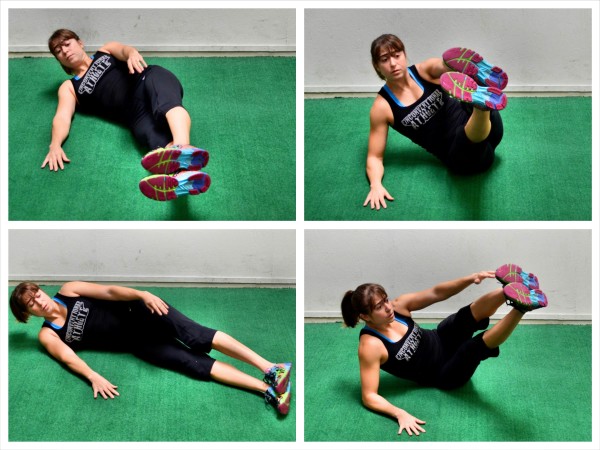
To do Oblique V-Ups, lie on your side, slightly rocked back onto the fleshy part of your glute so that your body is slightly rotated open toward the ceiling. Place your bottom arm out in front of you just below shoulder height and angle your straight legs out a bit out in front of you with one stacked on top of the other.
Keeping your legs together, lift your feet up toward the ceiling as you crunch your upper body up to reach your top arm toward your feet. “V up” on your side, pressing off your bottom arm as you use your abs to lift your legs and reach your top hand toward your toes. Lift your legs up as high as you can as you reach up as high as you can.
Then relax back down, but don’t completely release at the bottom. Keep your legs slightly lifted and only lightly touch your bottom shoulder back down to the ground.
Then lift back up, pushing through your arm on the ground as you use your abs and glutes to lift your legs and reach up toward your feet.
Complete all reps on one side before switching.
V-Ups – The V-Up is a tough full-body Sit Up Variation that requires a lot of core strength and stability as well as strong quads and good mobility.
Beginners may need to keep their knees bent as they perform this move or they may want to start with a Basic Boat Hold to help them build their core stability.

To do the V-Up, lie flat on your back with your legs out straight in front of you and your arms reaching back overhead. Then, keeping your legs out straight, lift your legs a bit off the ground and press your low back down into the ground. Engage your abs by also slightly crunching your shoulder blades up off the ground.
Then lift your feet up toward the ceiling, keeping your legs straight, as you come up to balance on your butt, reaching your hands up toward your toes. Try to lift up as high as you can. Pause for a second, holding while balanced on your glutes.
Beginners may need to bend their legs more or even start with a Full-Body Crunch.
Then lie back down, but do not fully relax onto the ground. Keep your abs engaged and don’t touch your feet down or completely relax your shoulders down. Reach your arms back overhead and then pike back up, reaching your hands back toward your feet as you again balance on your glutes.
Make sure you feel your abs working and not your low back taking over.
Alternating V-Ups – If you aren’t yet ready for full V-Ups or if you want to add some variety to the Bicycle Crunch, you should try Alternating V-Ups. This is another great rotational exercise to really work and challenge your abs.

To do Alternating V-Ups, lie flat on your back with your legs out straight in front of you and your arms down by your sides. Lift one leg up toward the ceiling and then lift your other leg up off the ground, squeezing your glute. Press your low back into the ground and engage your abs as you lift your legs up.
Then crunch your upper body up as you reach your opposite arm up toward the toes of your raised leg. Press lightly through your arm on the ground as you press your low back into the ground and reach up as high as you can, rotating toward that raised leg. Squeeze your glute of the leg close to the ground to help protect your low back. Do not touch that leg down on the ground. Keep it up higher to make the move easier.
Then lower the raised leg as you lift the other leg up toward the ceiling and crunch up to reach up toward that opposite foot. Keep alternating sides.
Make sure to keep your low back firmly pressed into the ground as you reach up as high as possible while keeping your legs as straight as possible.
Beginners may need to touch one leg down to the ground instead of keeping it up off the ground. They may also need to bend their knees more.
Move quickly, crunching up as high as you can.
Full-Body Crunch – This Crunch Variation will challenge and work your abs – lower, upper and everything in between. Because this move combines the Basic Crunch with the Lower Body Crunch, it is a very challenging move. Make sure your abs are actually working when you do it and that your low back doesn’t take over.

To do the Full-Body Crunch, lie on your back with your legs out straight in front of you and your arms reaching overhead. You can also place your hands behind your head or even across your chest. Then press your low back down into the ground and engage your abs as you lift your feet up off the ground. The higher up you keep your legs, the easier the move will be.
Then tuck your knees in toward your chest as you crunch your upper body up, lifting your shoulder blades up as high off the ground as you can. Keep a space between your chin and your chest as you lift your shoulder blades up off the ground. You can keep your hands behind your head or pull your hands down from overhead and drive your elbows toward your knees.
Crunch both your lower and upper body together, pressing your low back into the ground then relax your upper body back down as you kick your legs out straight. Do not touch your heels to the ground as you extend back out. The higher up you keep your legs as you straighten them back out, the easier the move will be. Do not let your low back come up as you straighten out. Keep your abs engaged. If your low back takes over, regress the move.
Then crunch back up.
Beginners can also do a knee tuck and then keep their knees bent and tap their toes down if kicking their legs out is too much to start.
Russian Twists – Russian Twists are another great variation of the Boat Hold that add in rotation. They can be done without weight by beginners or you can use a dumbbell, med ball or even Battle Ropes to make them harder.
To do Med Ball Russian Twists, start seated on the ground with your knees bent and feet flat on the ground. Hold a med ball in both hands and then rock back to balance on your butt, lifting your feet up off the ground. Engage your abs as you hold the med ball up at your chest.
Then, without letting your feet touch down, rotate your upper body and reach the med ball down outside one hip to touch the ground. Keep your feet up off the ground and bring the ball back center before rotating to reach it down to the ground outside your other hip.
Complete big rotations and move quickly while staying balanced on your butt. Do not let your low back engage as you go.
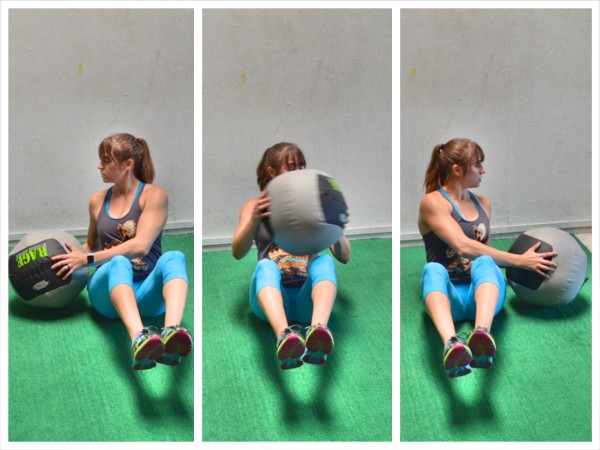
You can also do a Partner Med Ball Russian Twist. Check it out here.
To do the Battle Ropes Russian Twist, set up a Battle Rope and sit at the end of it. Sit in a foot or two from the end of the handles and then grab a handle in each hand with the handle pointing up toward the ceiling. Rock back and balance on your butt with your knees bent and feet up off the ground.
Then rotate your upper body and the handles down toward the ground outside one hip, keeping your feet up. Then lift the rope up and over your body to rotate the handles down outside the other hip. Move quickly from hip to hip, bringing the rope up and over your body while staying balanced on your butt.
Make sure you have some slack in the rope so that you can lift it over yourself. If you sit too far out, the rope will be too tight. Beginners may need to keep their heels down as they do the Battle Rope Twists.
Butterfly Sit Ups – This Sit Up Variation is a great way to work your abs and, because your legs aren’t out straight, it is a slightly harder variation. The Butterfly leg position can, though, help you keep your abs engaged and even help target your lower abs a bit more.

To do Butterfly Sit Ups, start seated on the ground and bring the bottoms of your feet together as you let your bent knees fall open into a Butterfly stretch. Bring your heels in toward your body (your mobility will determine how close you bring them in).
Keeping your knees open and the bottom of your feet together, lie back on the ground. You can extend your arms overhead or bring them into your chest. Then sit up, rolling up so that your low back stays connected with the ground until the end. Reach your hands toward your feet or keep them in at your chest. The more you swing your arms, the easier the move will be.
Then lie back down. Sort of roll back down. Don’t just go flat back down and let your low back arch. Make sure to sort of roll, so you press that low back into the ground.
Then repeat, sitting back up (again remember to sort of “roll” to engage those abs). Keep your feet on the ground. If you keep your legs out a bit straighter, it will be easier than if you bring your heels in closer to your body.
TFW Sit Ups – The TFW Sit Up is another great full-body Sit Up Variation. This move will work your abs and prevent you from using your arms to help you up. It is more challenging than the Full-Body Crunch, but not as tough as the V-Up. It is sort of a Cherry Bomb, but without opening up or having to balance at the top. This is also a great Sit Up Variation for testing and is used by Training For Warriors as one of their fitness tests.

To do the TFW Sit Up, lie on your back with your legs out straight in front of you and your hands in under your chin.
Then sit up, bringing your knees in as you move to place your hands on your shins. As you come to a tucked seated position, place your feet on the ground. Don’t swing your arms overhead to sit up. You can move your arms from in under your chin to around your legs at the top while you are seated.
Then lie back down, straightening your legs back out in front of you as you bring your hands back in under your chin. With this Sit Up Variation, you can release at the bottom and touch your shoulders and heels down.
Repeat, sitting back up as you bring your knees back in, grabbing your shins. Move as quickly as possible. As you sit up and lie back down, make sure not to arch your low back. Press it into the ground and feel your abs working.
If your low back takes over, try a Basic Sit Up or even a pelvic tilt progression.
Full Sit Up – The Full Sit Up is the Basic Sit Up and can teach you how to “roll” more to really engage your abs as you sit up instead of using your low back.
To do the Full Sit Up, you can do a variation where you reach up overhead as you sit up or you can reach toward your toes. Reaching toward your toes can help if you struggle to roll up and keep your abs engaged and working.
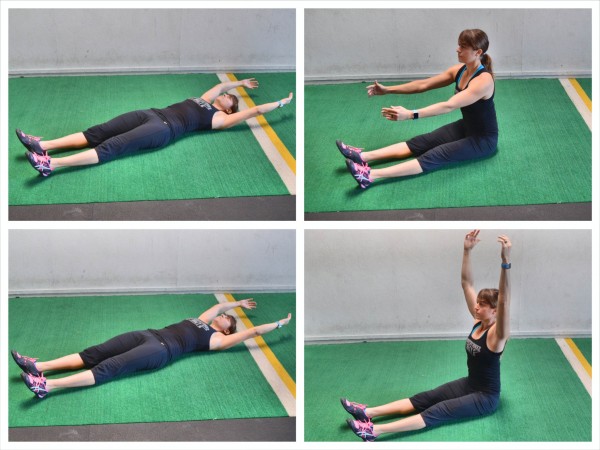
To do the Full Sit Up (with a reach toward the toes), lie back on the ground with your legs out straight and your arms overhead. You can also reach your arms up toward the ceiling if you want to limit the assistance you get from “swinging” your arms. Then roll to sit up, first lifting your shoulder blades then the rest of your spine and finally your low back.
As you “roll” up, reach your hands forward and toward your feet. Then lie back down, reaching your arms back overhead.
Repeat, sitting back up. If you struggle to sit up, you can hold light weights in your hands. The weights actually can make it easier.
Watch the video for both variations of the Full Sit Up!
Sprinter Sit Ups – The Sprinter Sit Up is another variation of the V-Up that isolates and works each side a bit more independently. It will work your quads quite a bit while also building core stability.
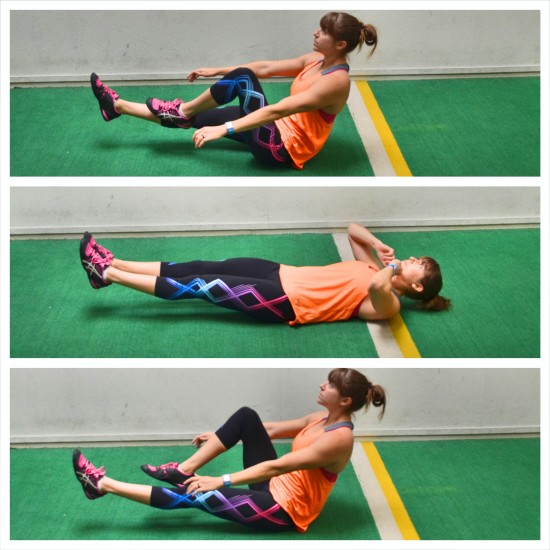
To do the Sprinter Sit Up, lie on your back with your legs out straight and your arms down by your sides. Then raise both legs just slightly off the ground. Beginners may keep one leg on the ground.
Then, sit up, moving to balance on your butt as you bend one knee and bring it in toward your chest. Reach your arms out toward your feet as you come to balance on your butt with one knee drawn in.
Lie back down and straighten both legs back out, but try to keep them up off the ground. Also, do not fully relax your shoulders back on to the ground as you lie back down. Keep your abs engaged.
Then sit back up and bring the other knee in toward your chest. Keep alternating, trying to keep both legs up off the ground when you straighten back out. Make sure you feel your abs and not your low back working.
Workouts Using Crunches and Sit Ups
One of my favorite workouts using Crunches and/or Sit Ups is the little cardio blast below. You can use any piece of equipment where it says “Rower” and then do the other exercises listed.
Workout:
Complete 4-5 rounds of each circuit. Rest equal to the time you worked between rounds. Then rest about 2 minutes between circuits.
#1:
20 seconds Rower
5-8 reps Burpees
5-8 reps Banana Twists
#2:
20 seconds Rower
3-5 reps per side Sit Thrus
8-10 reps Cherry Bombs
#3:
20 seconds Rower
5-8 reps per side Skater Hops
8-10 reps Butterfly Sit Ups
For more workouts using Crunches and Sit Ups, check these out:
Remember, Crunches and Sit Ups shouldn’t be the only core work you do, but they do have their place in a well-rounded workout program. They can not only be fun, but also be a great way to learn to engage your abs and even burn them out!

